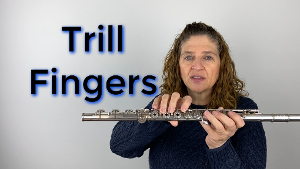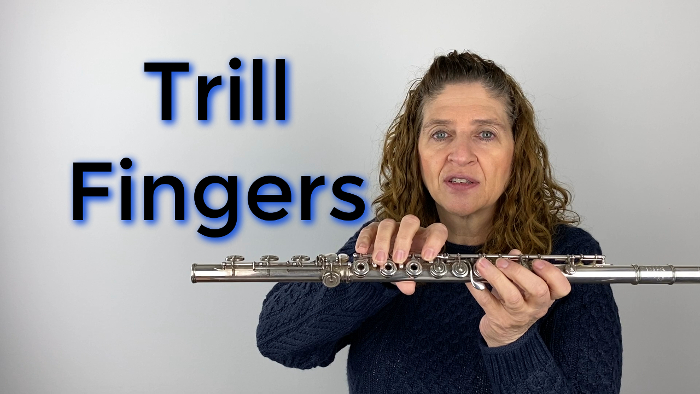Have you ever just worked on your trills? There’s a really good exercise in Taffanel and Gaubert’s 17 Grande Exercises at the very end of the book that you can use to work on your trills and to learn your trills. But today I just want to talk about the fingers that you use for your trills. Because oftentimes I think we use the wrong fingers.
Move Your Fingers Up
We have three trill keys down here in our right hand, and each of those trill keys needs to be played with a different finger. So, when you are doing your trills, you need to move your finger up to the trill key.
When I first started learning flute, I moved my first finger up to the trill key and down to the trill key! Of course, for a long time, I did not even know what I would move my first finger up for. What was that key even used for?
But that is not a great pattern because that one finger has got enough to do. He has his own key and a trill. It is too much to ask him to play a third key.
Each Trill Has It’s Own Finger
So, we want to move up to trills. If we move up to trills, each finger has its own trill. Additionally, that gives each finger a chance to exercise its muscle.
I really think that you need to work on trills, not just for the fact that you are going to trill and that each time we trill we have to do it a little bit differently. But because when you work on trills, you work on weak fingers and their muscle control.
You know what I mean – when you trill with a weaker finger, that trilling is just not fantastic. So, the more you work on it with that finger, the stronger that muscle gets, and the better that trill sounds.
Plus, that finger then works better in all your technical exercises as well. So, it is going to be doubly beneficial for you to work on your trills.
Exercise the Weak Fingers
For example, our middle finger, our E finger is often fast enough. But he is often just inconsistent when trilling. It is similar with the first finger, where you use the side of your finger to trill. And remember that when you move up to this trill with your first finger, you do not play it with your fingertip. You could, but it is really awkward to move your whole entire hand to do this. So, you, you just use whatever side of your finger reaches over there and hits that trill key. That part of your finger is what you use to trill. There is no right or wrong as to what part of your finger that you use. You just do not want to bend your finger. If you bend your finger to use your fingertip, you have to move your entire hand up here to do that. And it is okay when you trill to get off the pinky key, your E-flat pinky, that is fine.
But when you work on your trills, you get your uncoordinated fingers to have a chance at trilling.
You Can Learn This
But you want to work on trills, you want to practice trills, and you want to move up to your trills. You can break old habits. You can change. I was probably in college when I learned this method of trilling. But I learned it. So, anybody can learn to do this. It just takes a little bit of thought to move up to the trills. Moving up to trills will make a lot of sense to you once you learn to do it.
This is something that is accessible. You can do this.
So, work on your trills, your fingers will be glad, your technique will be glad, and your trills will be phenomenal.
Have fun!
DoctorFlute
Watch me demonstrate this:


FluteTips 49 Every Trill Has its Own Finger

